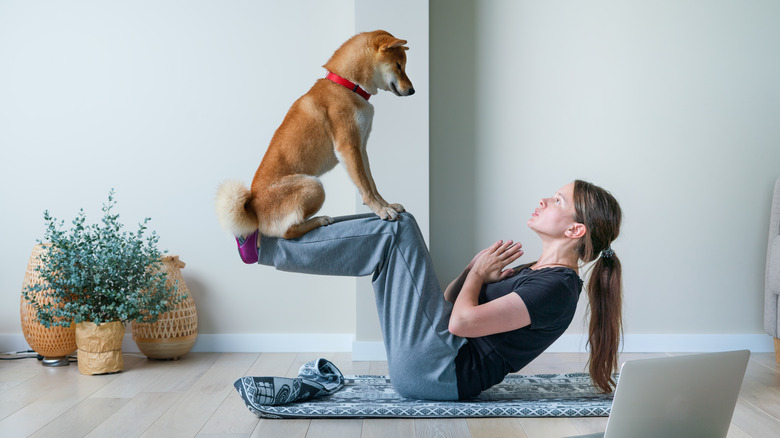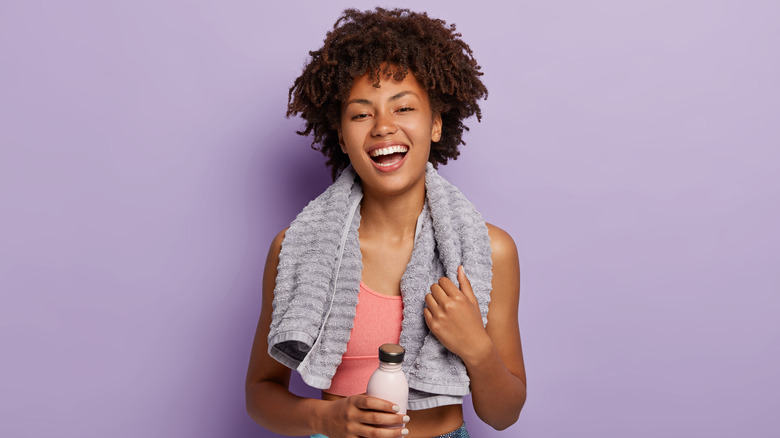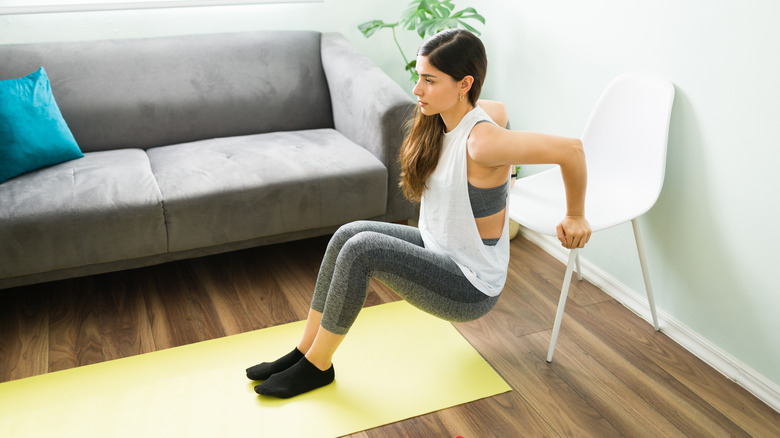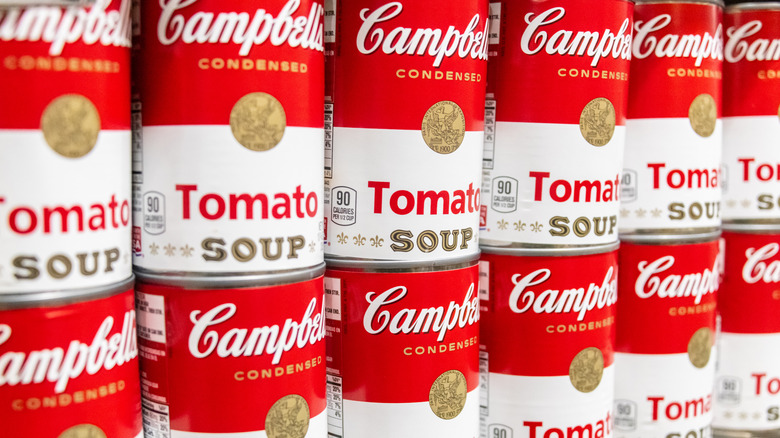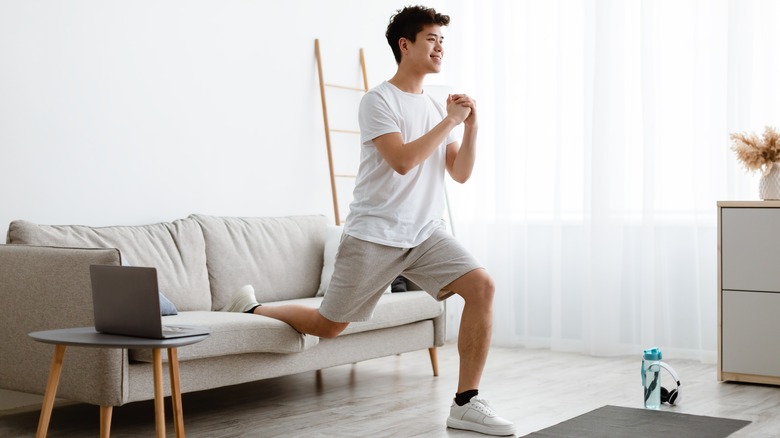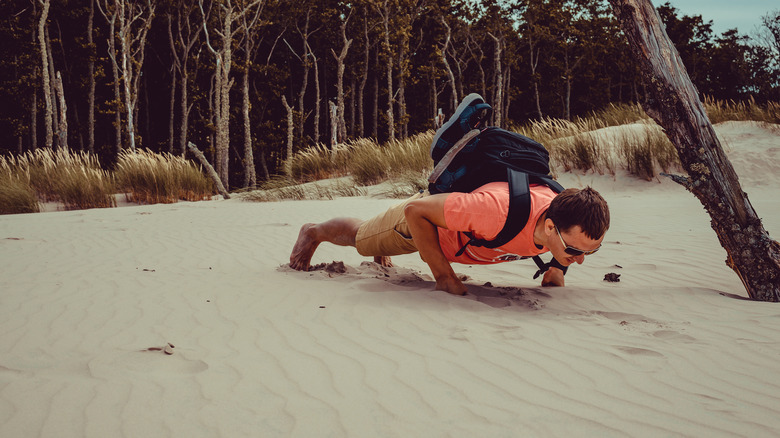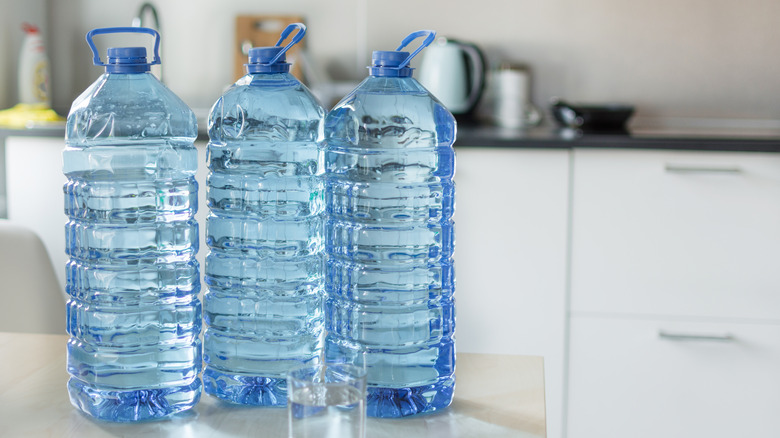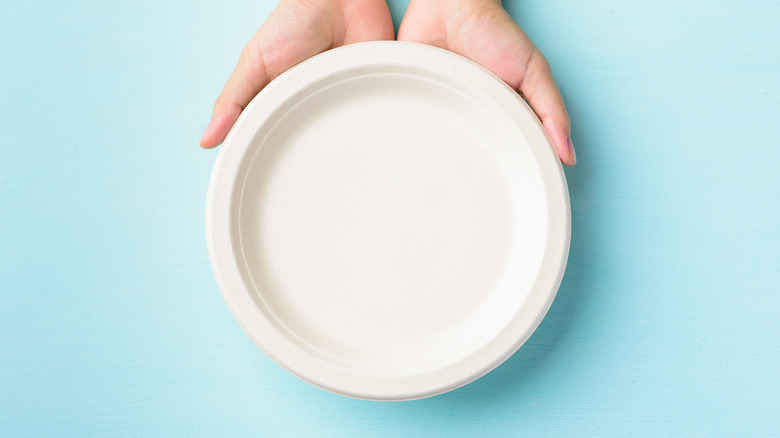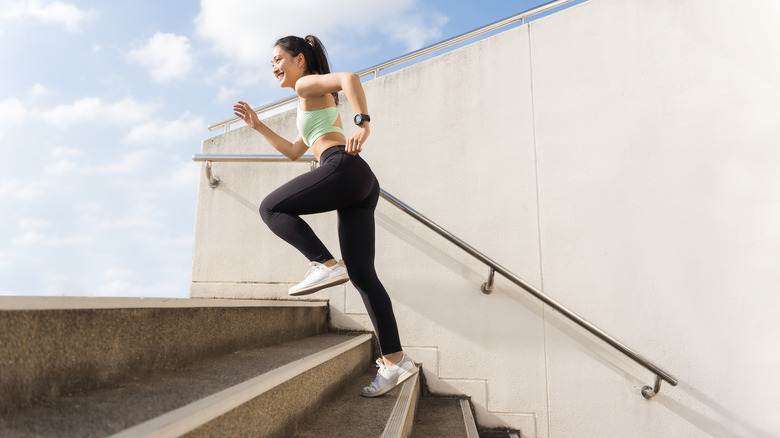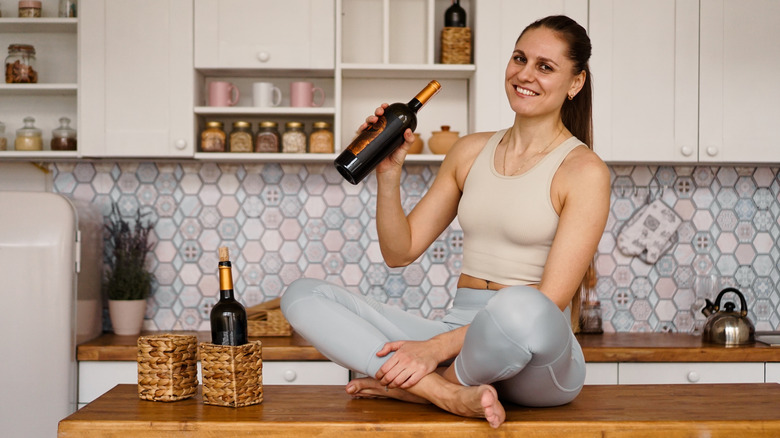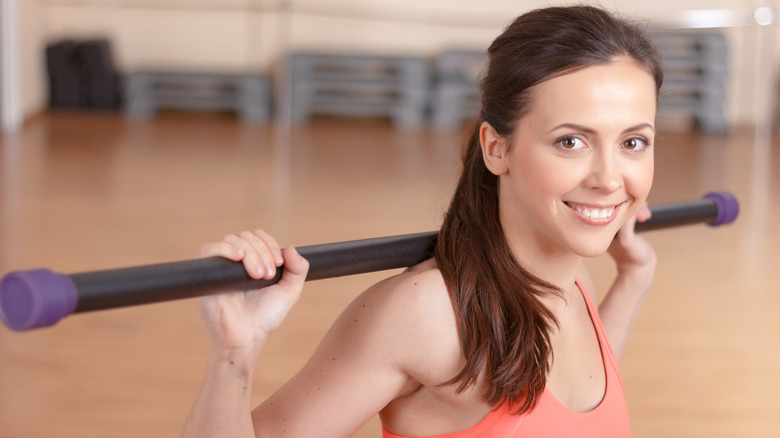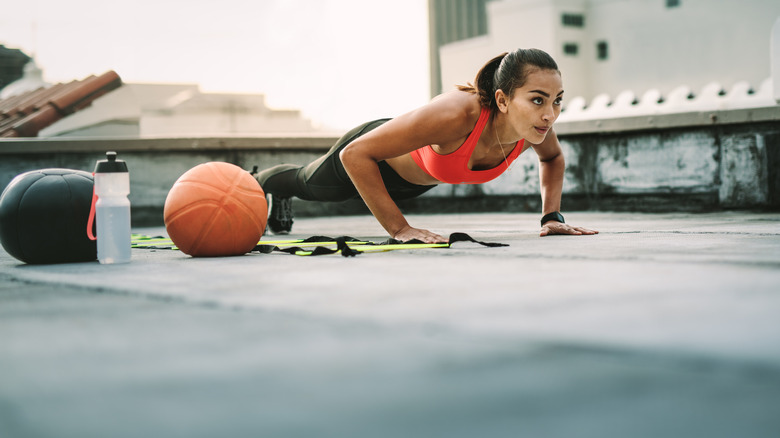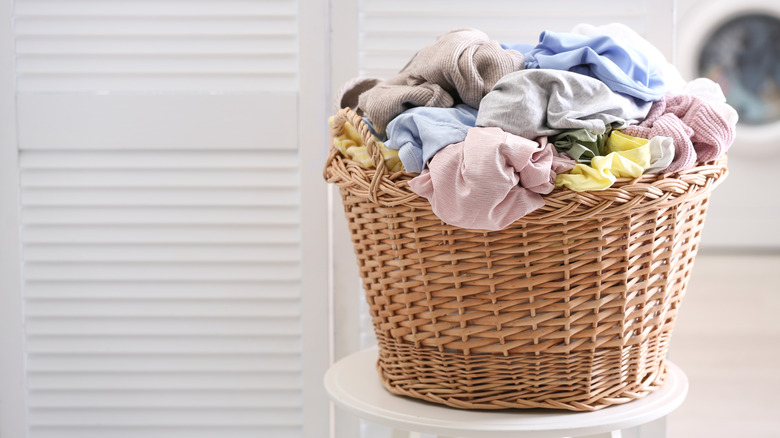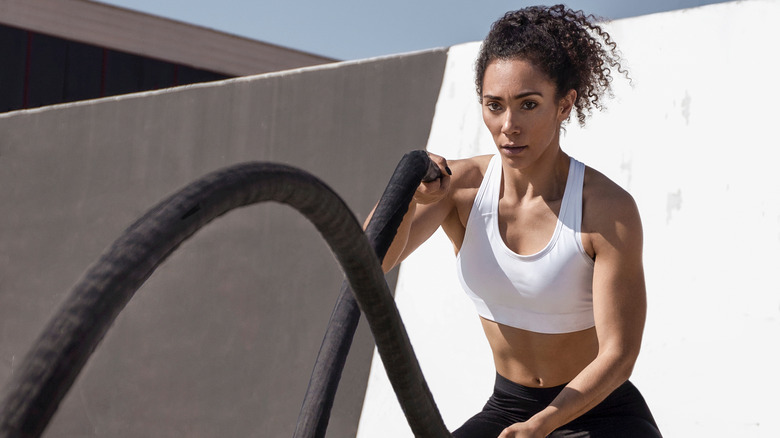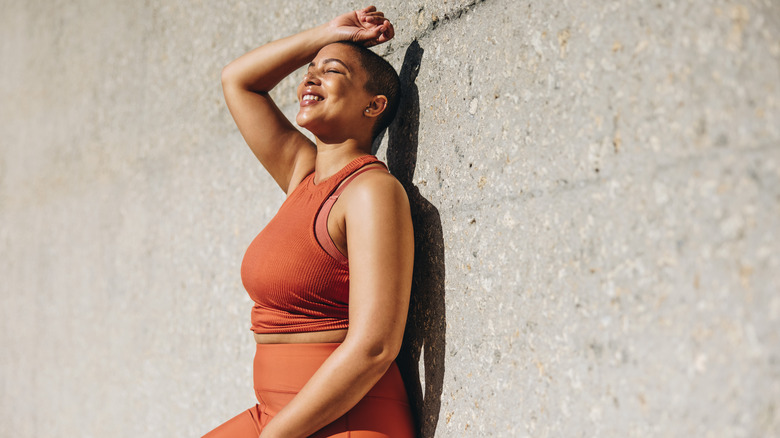Things In Your House You Can Use In Your Workout
Keeping fit can sometimes feel pretty expensive. While we all know deep down that exercise costs nothing, between endless advertisements for new sneakers, the latest yoga mat, and those new-fangled exercise machines, it's easy to get fooled into thinking that fitness is a pricey hobby. And that can often show up in our monthly expenses: With the average price of gym membership in the U.S. costing $37.71 monthly in 2021 (per Run Repeat), you could be looking at spending well over $400 a year on a place to work out alone, before taking into account exercise gear, nutrition, and any additional extras.
But before you resign yourself (usually with a weary sigh) to the cost of working out, take a look around your home. It may not seem like it, but your house is a veritable treasure trove of things that you can use to work out, and with a bit of canny thinking, you can get an excellent full-body blast with some objects you may never have thought to use. Here at Health Digest, we wanted to lift the lid on how everyday objects can be used to work out. Join us as we take a look.
Use a towel to add resistance
That thing you dry yourself with every day? It might be good for more than just shower-time, folks. Instead of stumping out for the latest, most expensive pair of dumbbells or a set of resistance bands, an everyday hand towel can be used to get a killer workout. "By using your own body weight and resistance from the towel you have the ability to tone muscles from the comfort of your own home, on the road, or even at the gym," says Crank Cycling Studio to Women's Health. The natural resistance from the towel's fabrics can help fire up your arms in upper-body-focused movements and keep them engaged during core and lower-body exercises.
Progressive angular twists are a simple but effective exercise to target your arms with a towel. Hold the towel out in front of you, one side in each hand. Start by performing gradual rotations of the towel from side to side, eventually increasing the size of your movements until you're performing a 180-degree rotation. Slowly reduce the size of your movements to the smaller rotation and then repeat the escalation, for approximately two minutes. Ab exercises like Russian twists performed with a towel stretched between each hand, or back exercises like towel rows performed with your towel wrapped around a bedpost can complete your upper-body focus.
Chairs can be used for cardio and strength
If you're at a desk, take a moment to appreciate the structure you're perched on: The chair. Sturdy, reliable ... and versatile? Your chair's useful for more than just sitting upon, and can be incorporated in a variety of exercises to give you a cheap workout. For your cardio, chair taps are a quick way to get your heart rate pumping, as Men's Journal shows. Simply stand in front of your chair, facing its seat, and bring alternate feet up to tap it in a running motion.
Performing rounds of chair taps in a Tabata style can get you in the zone for strengthening exercises, for which the seat of the chair becomes your best friend. Try taking your mountain climbers to the next level by doing an elevated variation, placing your toes on the seat of the chair and your hands out in front in a plank, and then bringing your legs into your chest alternately in a slow, controlled manner (via Men's Journal). In the same position, elevated pushups can help target your upper pectorals and shoulders more directly than regular pushups (per Healthline). With any exercises that incorporate a chair, though, remember that safety is key. Your chair needs to be sturdy and on a flat surface where it's not prone to slip, and your feet need to be securely placed on the chair.
For movements with light weights, use soup cans
Okay, so it may not be the most fashionable way to work out, but we can guarantee you it's one of the most convenient. Using soup cans instead of weights is the perfect solution if you're a fan of canned goods, as it's likely that you'll already have them hanging around at home! To target your back muscles, try performing a reverse fly with a pair of 23-ounce soup cans, as ACSM-certified exercise physiologist Brook Benten recommends for Prevention. Standing in a neutral position, lift one leg out behind you and pivot forward until your extended leg and upper body are at a right angle. Hold the soup cans down toward the floor in front of you and pull your arms out wide, engaging your upper back muscles while you do so. Slowly return them to your starting position, and repeat for 15 reps.
Remember, just because soup cans are lighter than some dumbbells doesn't mean they can't be effective. "Lifting lighter weights can be just as beneficial as lifting heavy, depending on how you use them," states Aaptiv trainer and functional movement specialist Michael Septh (via Aaptiv). The key to getting the most out of light weights, according to Septh, is to really nail your form, focus on more reps until you feel fatigued, and breathe deeply from your belly during the movements.
Your couch isn't just for reclining on
We understand why you might feel a little hesitant about turning your couch, the site of all that is comforting and cozy, into a workout aid. But we're fans of a multipurpose item, and we guarantee that you'll enjoy your couch even more after using it to exercise. Your sofa can be used for a surprising number of movements. A variation on a single-leg hip thrust, for example, can be performed with your back against the seat of your couch, as Livestrong shows. Sit on the floor with your knees up and your feet planted on the ground. Pull one of your knees into your chest, and with the foot still on the floor, push up, raising your hips toward the ceiling, activating your glute muscles. Slowly return to your starting position and repeat 15 times, switching legs to work the other side.
If you're trying to focus on balance practice, your couch could also be the perfect tool for this, according to Verywell Fit. The softness of your couch cushions can help to activate your stabilizing muscles, helping to work your body in a way that exercises on harder surfaces may not. Balancing on a cushion to do pushups, for example, is a great way to challenge the stabilizing muscles in your upper body.
A backpack is an adjustable weight
Chances are, your house has a huge number of things hanging around, from books to food tubs, that might offer the perfect weight for a workout, if only they weren't so awkwardly shaped. Enter the backpack, friends. By filling up a backpack with items, you can not only create a weight that's useful for a huge number of at-home exercises, but you create one that's fully customizable to your needs. Given that these accessories are usually designed to take a fair amount of load, as GQ Magazine says, they're also a good way to create a slightly heavier weight to emulate a dumbbell or kettlebell.
To blast your shoulders with your backpack, try a single-arm shoulder press. Fill a backpack (ideally one with a strap at the top of it) with your desired weight and then, as you would with a kettlebell, hold it at shoulder height, your palm facing toward you. Slowly, while breathing out, push the backpack up, and then lower it down with the same level of control. Complete for 12-15 reps for each arm. To continue in the upper-body vein, weighted push-ups are a great chest exercise with a little added effort — simply pop your backpack on your back while you're doing a regular push-up.
Gallon water bottles provide weight
Anyone who says you have to buy a set of dumbbells to effectively work out at home has never seen a gallon water bottle before. Gallon jugs are an excellent substitute for a dumbbell or other weight, and for many people, incorporating one into their workout will be an effective boost for bodyweight exercises. With a full gallon water bottle weighing in at around 8.75 pounds (per Livestrong), using two of them will add challenge to larger exercises like squats, lunges, or body swings. If you're not ready to progress to the full amount of weight, you can always use less water — and the best part is, you have a ready supply of hydration on hand for when you work up a sweat. Win-win!
Try using a gallon jug in an overhead press sit-up to target your abs, while also keeping your arm muscles activated. Move into a standard sit-up position, with your feet flat against the floor, knees up, and your water bottle resting on your chest, one hand on each end of it. Perform a sit-up, and as your upper body moves toward your knees, push the gallon jug up and over your head, with your arms parallel to your upper body. Hold briefly, and then lower back to your starting position. Aim for three sets, with 12 reps per set.
For a surprising workout variation, try paper plates
Okay, so we get how paper plates might not look like the best workout tool on paper (get it? On paper, because they're paper pla- ... yeah, you got it). But your standard paper plates left over from your last barbeque or kid's birthday party are excellent substitutes for more expensive gym sliders, as Shape shows. Sliders are "a great way to up the intensity of a bodyweight workout, without adding weights," according to FitandLit creator and Brrrn head trainer Janeil Mason, via Women's Health. By using sliders (or here, paper plates), your muscles are forced to perform constant additional engagement, due to the instability created by the movement, Mason says.
Positioning paper plates upright will ensure you get the best results, as well as using pure paper plates as opposed to disposable plastic or Styrofoam ones. What's particularly useful, too, is that paper plates can be incorporated to reduce impact from certain exercises without compromising their effectiveness. Try a sliding burpee, beginning by getting into a standard burpee position on the floor, crouching in a ball, with your hands and knees connected to the ground, with paper plates under each foot. Rather than jumping your legs out, slide your legs behind you, moving into a plank position. Pull your knees and feet back into the original position, and perform for 15 reps.
Your stairs are for more than just your lower body
Let's take a moment to consider the absurdity of this fact: Millions of people around the world (ourselves included) pay huge amounts of money to go to a big room where they use a machine that emulates climbing stairs. When they have stairs in their home, that they could use instead, for free. See where we're going with this? Although stair machines do carry their benefits, allowing a constant motion of climbing, using your regular stairs is pretty much the perfect substitute. What's more, stair climbing is just really good for you and your lower-body fitness. "You're able to work through a [large] range of motion at the hip and knee which can benefit your butt muscles, as well as the quadriceps, and hamstrings," says NYU Langone's Sports Performance Center exercise physiologist Heather Milton to Women's Health.
But workouts that incorporate your stairs don't just have to be lower-body-focused. Try performing tricep dips on your stairs to get your arms involved, or mountain climbers with your hands resting against the step, as Real Simple suggests. And remember, stair workouts don't have to be as boring as simply stepping up and down. Try a step-up to reverse lunge using the lower steps on your flight. Just be careful when stepping back off the stairs due to the height difference involved, and the potential for injury.
For a weight you won't mind drinking, try wine bottles
Okay, now this is a workout aid we can get behind. Why not combine your at-home exercise with the promise of what's to come afterward, by using wine bottles in place of weights, as Define.London founder and trainer Ashley Verma suggests to Cosmopolitan? We don't know about you, but a wine bottle in hand is a pretty strong motivator to kick that workout's butt.
With the average full wine bottle weighing in at 3.3 pounds (per Wine Turtle), these weight substitutes are well-suited to time-focused exercises that emphasize hitting higher reps, as in the wine bottle workout designed by Verma for Cosmopolitan. And by using a wine bottle in more creative ways, you can make sure every part of your body benefits. Rainbow kicks using a wine bottle to move your leg over are a great way to target your glutes with more precision. "Think of this as a game of 'don't knock the wine bottle' — that'll make sure you do it properly. Try to keep your hips still and avoid using your lower back as you kick your leg over the bottle. Your abs do the work here, as well as the glutes and your hamstrings," Verma advises.
Broomsticks can help train lesser-focused-on muscles
It might not be the most obvious choice for a workout at home, but a broomstick is an object that'll low-key take your exercise from good to great. Although broomsticks are light, the constant grip required during use will help challenge your forearm, grip, and wrist strength while you're focusing on other parts of the body, says Stack. Although grip strength isn't usually people's top priority to work on during physical exercise, maintaining muscular health and strength in your hands is important both for optimal performance during exercise, and for everyday activities, advises Wake Forest University's assistant athletic director of sports performance Ethan Reeve to the Washington Post.
Using a broomstick during multi-part exercises can help your workout activate numerous muscle groups in one go. For a single-leg squat to single-arm overhead press, begin by balancing on one foot, with the broomstick in the hand on the same side, held in the middle, resting on your shoulder in a shoulder-press position, as Stack says. Lower into a single-leg squat, and while moving downward, push the broomstick up over your head. While you rise to the original position, pull the broomstick down to your shoulder.
A basketball can help provide useful instability
Basketballs aren't just good for the court. If you've got a basketball (or any other similarly sized ball) lying around at home, using it during exercise is a surprising way to increase your muscle activation. Balancing with a basketball during certain movements, such as with push-ups performed using the ball, creates a level of instability that then forces your muscles to activate more, as seen in a study published in the Journal of Exercise Science & Fitness. This could then increase your workout's overall efficacy.
Doing push-ups on a basketball might feel daunting (if not downright scary), so try working your way up in difficulty level. Begin by performing an uneven push-up, with your hands around shoulder-width, and with one hand resting on a basketball, the other placed on the floor, as Pure Sweat Basketball shows. To make this variation easier, place your knees on the floor while you do so. Once you've mastered that, you can move on to even more challenging push-up variations, like the 2-ball push-up, balancing on two basketballs, one under each hand. We recommend only doing this if you're very comfortable you can perform it safely, though, and to acclimatize yourself to the movement by first performing it with your knees on the ground.
Laundry baskets can help you focus on your glutes
Waiting for laundry to finish isn't exactly everyone's idea of a good time. But if you're waiting for the washing machine's spin cycle, it might be worth grabbing a few minutes to use your laundry basket for a quick workout. The laundry basket is particularly useful for one part of your body: your butt, says fitness trainer Steve Cook to HuffPost. "There's no better way to work the booty than to do something like a heavy back squat [or] deadlifts," says Cook, and with a full laundry basket, a sumo deadlift variation is an ideal move to do at home. In contrast to normal deadlifts, for sumo deadlifts, "you move your legs out a little bit wider, your hands are in close, and it's pretty much like picking something off the floor, like a laundry basket ... Practice picking it up," advises Cook.
But when you're working out your glutes, don't forget about your lower back. Your lower back is an often-neglected part of the body that can hinder your workouts' progression if not strengthened, Cook says. To strengthen it at home, perform simple exercises like supermans and glute bridges, says Healthline.
Ropes and chains can shake your workout up
A car-free garage might provide you with the perfect space for a home workout. And the objects that you have lying around in there might help more than you think. Any old rope you have in your home or garage can be used in place of a suspension trainer, with a rope slung around a sturdy surface (like a tree branch, or a weight-bearing beam) allowing you to do suspended push-ups, planks, pull-ups, and other exercises without heading to the gym, says Verywell Fit.
And if you happen to have any long, heavy chains hanging around, they make the ideal substitute for battle ropes, when tied to a secure object. Battle rope training might seem intimidating, but when mastered it offers an effective way to target lesser-used muscles, contribute to increased mobility, and help keep your workouts fresh, according to EVO Fitness. Battle ropes are also highly effective in helping to improve cardiovascular fitness and burn energy, with just a 10-minute workout providing a serious cardiovascular result, as a study published in The Journal of Strength and Conditioning Research shows.
When all else fails, there's your wall
You can't get more easy and convenient than this. If you're really struggling for objects to use to work out at home, your trusty walls have you covered. Using a wall to work out is, in our opinion, an underrated method of exercising. And as certified personal trainer Amy Roberts says via Women's Health, an efficient workout can be achieved with just three feet of wall space.
Begin with shoulder climbers, starting in a squat position with your back against the wall and using your lower body to push up and lower down the wall's length, activating not only your larger leg muscles but your shoulders too. The L-handstand step-up is another challenging wall move that'll challenge your core and shoulders. Move into downward dog, with your heels pushing against the wall behind you. Take one leg and step it up against the wall, about to the height of your hips. Repeat with the other leg, so that both of your feet are against the wall, with your hands remaining in the downward dog position. Repeat this for four reps, and then do the exercise again, with your other foot moving into position first.

